Kosteniuk to give Culinary Master Class in St. Petersburg on May 20, 2011
 Hello everybody!
Hello everybody!
Now that the European Championship is over, tomorrow I fly to Moscow and then immediately to St. Petersburg where I will give a Culinary Master-Class with the Norwegian Seafood Council on May 20, 2011, at 4 PM at the Stroganoff Steak House (Строганофф Стейк Хауз). Below you can find the Press Release in English & Russian. You can also download the Russian Press Release or the English Press Release. I also have a blog on the site zdr.ru (in Russian about health).
The Norwegian Seafood Export Council presents
Culinary Master Class by Chess Queen™ Alexandra Kosteniuk
“Menu for Champions” – a part of Fiskesprell Communication Campaign
Media Release
May 20, 2011
On May 20, 2011 in St.Petersburg the Norwegian Seafood Export Council presented the culinary master class for children coached by International Grandmaster, 12th Women’s World Chess Champion Alexandra Kosteniuk. Ms. Kosteniuk was assisted by Aleksander Denissov, chef of Marco Polo restaurant and winner of the restaurant festival in St.Petersburg in 2010. The project’s partner was the Children’s Culinary Club of St.Petersburg led by Ksenia Zhuravlyova.
Olga Gilerovich, Director of NSEC Communications in Russia, attended the master class. “The goal of the master class is to deliver information about the health benefits of fatty fish and Omega 3, which is particularly important for children who are growing and have to master various tasks both at school and at home. Incidentally, a special project known as Fiskesprell was designed and launched in Norway to increase seafood consumption among children”, Olga says. – Norwegian Salmon is very delicious, therefore children are likely to enjoy eating it from early years. Norwegian Salmon offers multiple cooking opportunities for the whole family. Our collaboration with Alexandra Kosteniuk began in 2010 in Moscow from the awareness that every child is potentially a champion in something. Knowing what reigning and future champions actually eat is vital both to parents and their children. Today we continue to promote the Menu for Champions in St. Petersburg.”
In addition to cooking with children (the original recipe was Norwegian Salmon in Puff Paste with Partridge Berry Jam and Orange Carpel ), Alexandra held a small chess simul with the young master class participants and journalists. “There is a genius living in every child. The task is to discover it”, says Alexandra. “A human grows by trying and learning new things, so the greater the knowledge acquired in childhood, the richer and more colorful is the future life. Any skills acquired in childhood will be remembered forever, therefore, it is essential to focus on child’s all-round development.”
Seafood is brain food, and Omega 3 fatty acids help prevent both learning difficulties and dyslexia.
Sixty percent of our brain consists of fat. Scientists believe that at least 30% of this fat is Omega 3 fatty acids. These Omega 3 acids are necessary to develop the cells in our body. Even though we do not produce additional brain cells after the age of two years, the brain cells grow and develop “tendrils” to other cells, which is important for learning. This is particularly vital for children who are growing and have to master small and large tasks both at school and at home. Children need a constant and good supply of Omega 3. This enables children to maintain their concentration at a peak level throughout the entire school day, acquire knowledge and become intelligent. We can only take in Omega 3 through the food we eat – our body cannot produce it. We find Omega 3 primarily in fatty fish like salmon, trout, mackerel, and herring. So, let children and parents consume Norwegian salmon on a regular basis throughout the year.
RECIPE
Norwegian Salmon in Puff Paste with Partridge Berry Jam and Orange Carpel
Take the following for 1 serving:
Norwegian Salmon fillets 50 g
Marinade:
Orange juice 100 ml
Soya sauce 10 g
Honey 5 g
White pepper 1 g
Cut Norwegian Salmon fillets into squares sized 3.0 by 3.0 cm before putting it into the marinade for 2-3 minutes. Wait till Norwegian Salmon absorbs the desired flavor, then put it on tissue to remove excess moist.
Ready-to-bake puff paste (Talosto brand) 50 g
½ egg (yolk) 1 ea.
Sesame seeds 5 g
Basil in oil 2 g
Roll puff paste to make a sheet and into four straps each sized 1.0 by 10.0 cm. Put the straps onto each other to imitate a snowflake and put the marinated Norwegian Salmon in the center. Wrap the fish piece into paste straps before brushing with yolk and coating with sesame seeds. Bake in oven for 10 minutes at 180 degrees.
For decoration:
Dill 3 g
Partridge berry jam 30 g
Orange 20 g
Cress 5 g
Put the baked salmon balls on a plate. Decorate with partridge berry jam, orange carpel and cress.
For more information, please contact:
Olga Gilerovich, Director of NSEC Communications in Russia
Phone: 8 (916) 652-1763
gilerolga7@gmail.com, gilerolga@list.ru
www.seafoodfromnorway.ru
http://newseledka.livejournal.com/
Fiskesprell project: www.zdr.ru
***
Alexandra Kosteniuk
Alexandra was born in 1984 in Perm, Russia. She won her first international tournament at the age of ten. That victory was followed in 1996 by winning the World Chess Under-12 Championship for girls. At the age of fourteen Alexandra Kosteniuk was named the world’s youngest Woman Grandmaster. Year 2004 was marked with the Grandmaster title among men. Alexandra is twice Women’s World Champion in Chess960 (Fischer Random Chess).
Since 2006 Alexandra has been leading her children’s Chess School focused on assisting children in their first steps in the world of chess and uncovering the exciting and intriguing black-and-white kingdom to children. The key thing is to get children interested and make them want to continue at higher chess levels after the very first introduction to chess essentials. In teaching chess Alexandra relies on her own original methods with all the classes designed in exciting playing format with due regard for psychological and physical features of pre-school children. “After learning to play chess at the age of five, I have been continuously discovering the game’s endless opportunities”, says Alexandra. “In fact, every day I learn something new about this game that has become a part of my life.”
Under-10 and Under-12 European Champion (1994, 1996)
Three-times Under-12/Under-14 World Chess Champion (1996-1998)
World Chess Vice Champion (2001)
European Chess Champion (2004)
Champion of Russia (2005)
Women’s World Chess Champion (2008-2010)
Winner of the World Intellectual Games (2008)
Winner of the First Blitz Chess World Cup of the PCO (2009)
Two-times European Team Chess Champion in Russia’s National Team (2007, 2009)
Winner of 2010 World’s Chess Olympiad in Russia’s National Team
Alexandra Kosteniuk
alexandra@kosteniuk.com
www.chessqueen.com
Aleksander Denissov, St.Petersburg, Russia
Prize-winner, Norwegian Seafood Festival 2010; bronze prize winner, Baltic Culinary Star 2008 chefs’ competition; gold prize winner, Saphire Dish 2007, Jacinth Dish 2009 of the Precious Dishes of St.Petersburg series; member, Council of the Culinary College, Academy of Hospitality; chef-consultant, Academy of Hospitality; member, Russia’s National Guild of Chefs; member, Chefs’ Club, St.Petersburg. Chef, Marco Polo Hotel.
Project Partner: Children’s Culinary Club
Ksenia Zhuravlyova, the mastermind of the Children’s Culinary Club, was born in St.Petersburg. She graduated from the Department of History of the University is St.Petersburg. Ksenia’s work record includes various media jobs (such as a journalist, editor, photographic editor and photographer) in St.Petersburg and Moscow. Gradually she came to culinary and restaurant business as her current professional area of expertise. Ksenia’s first experience in working with children was in the charity project Children’s Rights To Children that she implemented in collaboration with the Commissioner for Child’s Rights. Ksenia established the Children’s Culinary Club in 2007 to pioneer serious approach to bringing culinary knowledge to children.www.vkusclub.ru
Fiskesprell Program in Russia
The Norwegian Seafood Export Council is pursuing Fiskesprell communication program designed in Norway to improve the quality of children’s diet in kindergartens and children’s public institutions. The key question posed in the program is: Children do like fish. Are the adults aware? A child will understand it much faster when told what he or she is going to learn after trying certain food. New skills take shape very much during decision-taking about what the child wants/does not want to try. Any kid who is often reminded what he or she dislikes is unlikely to be willing to try new food. When told that different foods may have different taste and when allowed to decide themselves what is tasty and what is not, children tend to develop positive attitude to any foods.
No child is born with a liking for chocolate and a dislike for fish. The concept of “fish” implies a lot: cod, saithe, salmon, mussels etc. Versatility of raw seafood offers an opportunity to make multiple foods. Therefore, if a child says he or she “dislikes fish”, offering salmon with pasta, caviar, fish patties or mackerel in tomato sauce might be a good idea.
Over the years children experience change of their taste sensations produced by food. Those who do not eat much today may well start showing great appetite tomorrow. Therefore, it is vital to grant kids the right of selecting their food and to avoid reminding what they might dislike.
Fiskesprell
A joint effort to increase seafood consumption among children
The project’s name Fiskesprell is a composite of the Norwegian “fisk” (meaning “fish”) and “sprell”, the word used to describe both the way a fish wriggles when it jumps and also people who are full of life and vitality.
A little about the background to Fiskesprell.
As far as diet development is concerned, Norway faces many of the same challenges caused by poor diets as other European countries, such as overweight and lifestyle illnesses, The plan of action highlights the fact that, from a general health point of view, it is beneficial for the population to increase its consumption of fish, both lean and fatty varieties. And in particular that children, youngsters and young adults should increase their consumption of seafood -in order not to deny themselves the beneficial health effects that seafood provides. One specific measure is therefore to implement initiatives aimed at children and young people to encourage them to increase their consumption of seafood.
The Ministry of Health and Care Services, the Ministry of Fisheries and Coastal Affairs and the Norwegian Seafood Export Council joined forces to implement the initiative – and by this the Fiskesprell project was born.
Who makes up the target segment for Fiskesprell?
The choice was in favor of public arenas where the chances of encountering all the different social classes are greatest. Consequently, our chosen arena was kindergartens and schools . The staff can influence what children learn to like and dislike and what they consider a natural part of their diet, and consequently what they eat when they are older.
What do we know about children’s diets?
Despite the focus on children’s diets over the last several years, children are still consuming:
too much sugar
too little dietary fiber
too much fat, particularly saturated fats
too little vitamin D and too little iron
Over 90% of 2-year-olds consume more saturated fats than the recommended amount, and 80% of 4-year-olds consume too much sugar .
Children should:
drink less sweet drinks
(squash and soda water)
eat much less sweets and sweet food
eat more coarse bread and corn products
eat varied vegetables and fruit
eat more fish and seafood
We can not only blame the children – it is we adults who have to do something about it!
Why should children (and adults) eat more seafood?
Children who eat seafood gain many benefits. Fish and other seafood are good sources of nutrients not found in significant quantities in other types of food.
These nutrients include:
vitamin D, which is important to good bone health;
marine omega-3 fatty acids, which are important to the development and function of the brain, as well as to the heart and the immune system;
iodine, which is important for energy conversion;
selenium, which is important to the immune system;
and proteins of high quality.
So children and young people should eat more seafood – but do they like it?
I do not know if this is the case where you come from, but in Norway I often hear adults say that children do not like fish. But no one is born with a liking for chocolate – and no one is born with a dislike of fish . So why has this myth that children do not like fish taken root? Well, if we ask the children directly, they will actually tell you that they do not like fish… But when I ask if they like pasta with salmon, or fish fingers – yes, they like those! Yet they claim they do not like fish! What can we learn from this? Allow me to recount some important considerations that we try to convey in our work with children and seafood:
We must stop asking children if they like fish. Ask instead if they like different dishes in which seafood is an ingredient. For instance, pasta with salmon. After all, no one asks children if they like cow or pig.
The adults’ attitudes are important. Children listen to what we say; they see our facial expressions.
Children best like food they have made themselves. Only adults think that food tastes best when others have made it. Children love to participate in making food. And it is a very good learning process. Therefore we encourage kindergartens and schools to make food preparation and cooking an educational activity.
As we grow up, our tastes change. What tasted good yesterday is not necessarily good today, but suddenly it can taste good again tomorrow. Therefore we should not be reminding children what they like and dislike, but let them taste and make up their own minds.
Maintain the focus on the joy of food and make seafood a natural part of the diet. Eating fish does not require special rewards or praise.
So the answer to the question is: yes, children do like seafood. If they say no, it is probably because someone has taught them to say it – either that, or the cook has not done a particularly good job.
Fiskesprell has therefore developed a course for kindergarten staff which focuses on:
knowledge of children’s diets, knowledge of seafood and the health benefits
providing inspiration and practical skills in preparing seafood in kindergartens
providing tips on how to use food and mealtimes proactively in the day-to-day educational work.
NORWEGIAN SEAFOOD EXPORTS UP IN APRIL
The value of exports of Norwegian seafood in April totalled NOK 4.2 billion. This is an increase of NOK 587 million or 16.3% compared to April 2010, according to the latest figures from the Norwegian Seafood Export Council. This year to date, the value of exports of Norwegian seafood totals NOK 18 billion, an increase of NOK 2.2 billion or 13.3% compared to the same period last year. This is an export record for the month of April and also for the January-April period. “Exports of Norwegian seafood are setting new records because there is a market demand for more Norwegian seafood combined with higher prices. The growth we are seeing in Norwegian seafood exports is attributable primarily to exports of Norwegian Salmon, although herring, mackerel and clipfish products are also contributing to increased export levels,” says Egil Ove Sundheim, director of market information with the Norwegian Seafood Export Council.
Exports of Norwegian Salmon showing continued growth
The value of exports of Norwegian Salmon in the first tertiary was NOK 10 billion, up by NOK 1.4 billion or 17% from the same period last year. In April, the value of Norwegian Salmon exports increased by NOK 356 million or 16% compared to April last year. The average price for whole fresh Norwegian Salmon in April was NOK 42.69, up from NOK 38.82 in April 2010. France, Poland and Russia are the biggest importers of salmon from Norway.
Growth in exports of herring and mackerel
In the first tertiary, exports of herring increased in value by NOK 349 million to a total of NOK 1.8 billion, an increase of 24%. In April, the value of exports totalled NOK 236 million. The value of exports of mackerel in the first four months of the year increased by NOK 212 million to a total of NOK 644 million. Exports in April were valued at NOK 65 million.
Exports of clipfish up
Exports of clipfish in the first four months of the year increased in value by NOK 116 million. The export figures for the different types of clipfish are as follows:
Cod exports increased in value by NOK 73 million to a total of NOK 659 million
Saithe exports increased in value by NOK 63 million to a total of NOK 464 million
Ling exports decreased in value by NOK 6 million to a total of NOK 43 million
Torsk exports decreased in value by NOK 17 million to a total of NOK 33 million
Exports of salted fish continue to grow
Exports of salted fish in the first four months of the year increased in value by NOK 125 million to a total of NOK 532 million. In April, exports totalled NOK 140 million, an increase of NOK 16 million compared to April last year. Cod accounts for the majority of exports so far in 2011 with a value of NOK 526 million.
Норвежский Комитет по Вопросам Экспорта Рыбы представляет
Кулинарный мастер-класс
чемпионки мира по шахматам Александры Костенюк
«Меню для чемпионов» в рамках коммуникационной кампании «Фискеспрелль»
Пресс-релиз
19 мая 2011 г.
20 мая 2011 в Санкт-Петербурге Норвежский Комитет по Вопросам Экспорта Рыбы представит кулинарный мастер-класс для детей, который проведет международный гроссмейстер по шахматам, 12-ая чемпионка мира среди женщин – Александра Костенюк. Александре будет помогать готовить Александр Денисов, шеф-повар ресторана Marco Polo – победитель ресторанного фестиваля в Санкт-Петербурге 2010 года. Партнером проекта выступит Детский кулинарный клуб Санкт-Петербурга (руководитель Ксения Журавлева).
На мастер-классе будет присутствовать Ольга Гилерович, Директор по коммуникациям для НКВЭР в России. «Идея мастер-класса – рассказать о полезных свойствах жирной рыбы и Омега-3, что особенно важно для умственного развития детей, которые растут и осваивают различные задачи в школе и дома. В Норвегии даже разработана специальная программа «Фискеспрель», направленная на увеличение потребления морепродуктов детьми, – говорит Ольга. – Норвежская семга очень вкусная рыба, поэтому дети с удовольствием начинают есть ее с самого раннего возраста. Эту рыбу можно по-разному готовить для всей семьи. Наше сотрудничество с Александрой Костенюк началось в 2010 году в Москве – как раз с понимания, что каждый ребенок потенциально в чем-то чемпион. Узнать чем питаются состоявшиеся и будущие чемпионы очень важно как для родителей, так и для самих детей. Сегодня мы продолжаем развивать тему “Меню для чемпионов” в Санкт-Петербурге».
Александра не только приготовит вместе с детьми блюдо по оригинальному рецепту «Норвежская семга в форме из слоеного теста с брусничным вареньем и долькой апельсина», но проведет небольшой шахматный турнир с юными участниками мастер-класса и журналистами. «В каждом из малышей живет гений, которого только надо разглядеть, – говорит Александра. – Пробуя и узнавая новые вещи, человек растет, и чем больше знаний он получит в детстве, тем насыщеннее и интересней будет его жизнь. Навыки, полученные в детстве, остаются в памяти на всю жизнь, поэтому так важно уделить особое внимание разностороннему развитию ребенка».
Морепродукты – это пища для мозга; жирные кислоты омега-3 помогают избежать затруднений в учебе и способствуют профилактике дислексии (неспособности к чтению). Жиры составляют 60% массы человеческого мозга. По мнению ученых из этого количества на долю жирных кислот омега-3 приходится не менее 30% – они необходимы для формирования клеток в нашем организме. Хотя по достижении двухлетнего возраста образование новых мозговых клеток у человека прекращается, уже сформировавшиеся клетки продолжают расти и образуют связи, направленные к другим клеткам мозга. Это особенно важно для растущего ребенка: ведь в школе и дома ему необходимо осваивать множество навыков. Организм ребенка постоянно нуждается в жирных кислотах омега-3. Поддержание в течение всего учебного дня концентрации жирных кислот на пиковом уровне позволяет ребенку легче усваивать знания и способствует повышению интеллекта. Жирные кислоты омега-3 поступают только через продукты питания: самостоятельно наш организм их не вырабатывает. Они содержатся, главным образом, в жирных сортах рыбы: семге, форели, скумбрии и сельди. Поэтому дети и их родители должны иметь возможность регулярно употреблять в пищу норвежскую семгу.
РЕЦЕПТ
Норвежская семга в форме из слоеного теста с брусничным вареньем и долькой апельсина.
Ингредиенты на 1 порцию:
Филе норвежской семги 50 гр.
Маринад:
апельсиновый сок 100мл.
соевый соус 10гр.
Мед 5гр.
перец белый 1гр.
Филе норвежской семги нарезать на квадратики размером 3,0*3,0см, затем положить в маринад на 2-3 минуты. После того как семга впитает необходимый вкус, нужно положить ее на салфетку, чтобы убрать лишнюю влагу.
Тесто слоеное готовое («Талосто») 50гр.
яйцо ½ (желток) 1шт
семена кунжута 5гр.
базилик в масле 2гр.
Слоеное тесто раскатать на пласт и нарезать на одинаковые 4 полоски размером 1,0х10,0см, затем полоски наложить друг на друга виде снежинки и в центр положить кусок маринованной норвежской семги. Легким движениями переплести кусок семги, смазать желтком и обсыпать семенами кунжута. Выпекать в течение 10 минут при 180 гр. градусах.
Декор:
укроп 3гр.
брусничное варенье 30гр.
апельсин 20гр.
кресс салат 5гр.
На подготовленную тарелку выложить готовые клубочки с лососем, оформить брусничным вареньем, долькой апельсина и кресс салатом.
Дополнительная информация:
Ольга Гилерович, Директор по коммуникациям для НКВЭР в России
Тел. 8 (916) 652-1763
gilerolga7@gmail.com, gilerolga@list.ru
www.seafoodfromnorway.ru
http://newseledka.livejournal.com/
***
Александра Костенюк
Александра родилась в 1984 году в городе Перми. Уже в возрасте 10ти лет она одержала первую победу на международном турнире, а в 1996 году выиграла чемпионат мира среди девочек до 12 лет. В возрасте 14 лет Александра Костенюк стала самым юным гроссмейстером среди женщин в мире. В 2004 году она завоевала звание гроссмейстера среди мужчин. Александра является двукратной чемпионкой мира среди женщин по шахматам-960 (“случайные шахматы Фишера”).
С 2006 года Александра возглавляет свою детскую шахматную школу-студию, цель которой – помочь ребенку сделать первые шаги в мире шахмат, открыть ему захватывающий и интригующий мир черно-белого королевства. Самое главное – заинтересовать детей и сделать так, чтобы после первоначального знакомства с основами шахматной игры, ребенку захотелось продолжить занятия на более высоком уровне. Для обучения основам игры в шахматы Александра использует свою авторскую методику, в которой все занятия построены в игровой и увлекательной форме, учитываются психологические и физиологические особенности детей дошкольного возраста. «Я научилась играть в шахматы в 5 лет и вот уже более 20 лет не устаю удивляться нескончаемыми возможностями шахмат, – говорит Александра. – Каждый день я узнаю что-то новое об этой игре, ставшей для меня частью жизни».
Чемпионка Европы до 10 лет и 12 лет (1994, 96 г.)
3-кратная чемпионка мира до 12 лет/до 14 лет (1996-98 гг.)
Вице-чемпионка мира (2001 г.)
Чемпионка Европы (2004 г.)
Чемпионка России (2005 г.)
Чемпионка мира среди женщин (2008-2010)
Победительница Всемирных интеллектуальных игр (2008 г.)
Победительница 1-го кубка мира по быстрым шахматам АШП (2009 г.)
Двукратная чемпионка Европы в составе сборной России (2007, 2009)
Победительница Всемирной шахматной олимпиады-2010 в составе Сборной России
Александра Костенюк
alexandra@kosteniuk.com
www.kosteniuk.com
www.kosteniuk.ru
www.chessqueen.com
Партнер проекта: Детский кулинарный клуб.
Руководитель Детского кулинарного клуба, Ксения Журавлева, родилась в Петербурге, училась на историческом факультете СПбГУ. Работала в петербургских и московских изданиях в качестве журналиста, редактора, фоторедактора, фотографа. Постепенно сложилась профессиональная специализация – кулинария и ресторанное дело. Первый опыт работы с детьми – в качестве руководителя благотворительного проекта “Права детей – детям”, осуществленного совместно с Уполномоченным по правам ребенка. В 2007 году создала “Детский кулинарный клуб”, в котором впервые начали применять серьезный подход к обучению детей кулинарии. www.vkusclub.ru
Программа Fiskesprell (Фискеспрель) в России
Норвежский Комитет по Вопросам Экспорта Рыбы проводит коммуникационную программу «Фискеспрель», разработанную в Норвегии с целью повышения качества питания детей в детских садах и детских общественных учреждениях. Основной вопрос, заложенный в этой программе – «Дети любят рыбу, но знаем ли об этом мы, взрослые?». Когда ребенку говорят, что он научится делать, если попробует то или иное блюдо, он понимает это гораздо быстрее. Новые навыки формируются во многом в ходе принятия решений: что ребенок хочет попробовать и что – нет. Малыш, которому часто напоминают, что он не любит, вряд ли охотно будет пробовать новое блюдо. Дети, которым рассказывают, что у разной еды бывает разный вкус, и что они сами могут решать, что вкусно, а что – нет, начинают позитивно смотреть на любые продукты и блюда.
Не бывает таких детей, которые от рождения любят шоколад или не любят рыбу. Понятие “рыба” охватывает очень многое: треску, сайду, семгу, мидии и т.д. Из этого разнообразного сырья можно приготовить множество различных пищевых продуктов и блюд. Поэтому если какой-то ребенок заявляет, что “не любит рыбу”, можно приготовить семгу с макаронными изделиями, предложить икру, рыбные пироги или скумбрию в томатном соусе.
С возрастом у детей меняются вкусовые ощущения от еды. Дети, которые сегодня едят не очень хорошо, могут буквально завтра демонстрировать великолепный аппетит. Поэтому важно предоставить малышам право самим определяться с выбором еды и не напоминать о том, что им может не нравиться.
«Фискеспрель»
программа увеличения потребления морепродуктов детьми
Норвежское название проекта “Фискеспрелль” [Fiskesprell] состоит из слов “фиске” (“рыба”) и “спрелль” – этим словом в норвежском языке описывают движение рыбы, извивающейся в прыжке над водой, и точно так же характеризуют подвижных и энергичных людей.
С чего начинался проект “Фискеспрель”?
Норвегия в питании населения сталкивается с теми же проблемами (избыточный вес, заболевания, обусловленные образом жизни), что и другие европейские страны. Разработанный в связи с этим план действий опирается на тот факт, что для сохранения здоровья населению целесообразно увеличить потребление рыбы как постных, так и жирных пород. Особенно необходимо повысить количество потребляемых морепродуктов детям и подросткам, а также молодым людям, которым совершенно не стоит лишать себя положительного для здоровья эффекта, сопровождающего потребление морских продуктов. Таким образом, к числу конкретных мер можно отнести реализацию ориентированных на детей и молодежь инициатив по стимулированию потребления ими морепродуктов.
В интересах осуществления такого рода инициатив свои усилия объединили Министерство здравоохранения и социального обеспечения, Министерство рыболовства и по делам береговой администрации Норвегии и Норвежский Комитет по Вопросам Экспорта Рыбы. Так появился на свет проект “Фискеспрелль”.
Кто составляет целевой сегмент проекта “Фискеспрель”?
Выбор пал на часть общества, в которой в наибольшей степени представлены различные социальные слои. Таким образом, выбранной ареной реализации этой инициативы стали детские сады и школьные учреждения. Персонал этих учреждений в состоянии повлиять на то, что дети будут любить и что – не будут, что они станут считать естественной составляющей своего повседневного питания и, следовательно, что будут употреблять в пищу, когда станут взрослыми.
Что мы знаем о детском питании?
Несмотря на то, что в последние несколько лет детскому питанию уделяется повышенное внимание, дети продолжают потреблять:
чрезмерное количество сахара
недостаточно грубых пищевых продуктов
избыточные количества жиров, особенно, насыщенных
слишком мало витамина D и железа
Более 90% детей в возрасте двух лет употребляют насыщенные жиры в количествах, превышающих рекомендованные нормы, а 80% четырехлетних детей потребляют слишком много сахара.
Детям следует:
употреблять меньше сладких напитков (фруктовых вод и газированных напитков)
есть гораздо меньше конфет и сладких продуктов
больше употреблять хлеба грубого помола и продукции из злаков
употреблять разнообразные овощи и фрукты
больше есть рыбы и морепродуктов
И дети тут ни в чем не виноваты: это мы, взрослые, обязаны предпринять все необходимые меры!
Зачем детям (и взрослым) употреблять больше морепродуктов?
Включение морепродуктов в рацион детского питания имеет многочисленные плюсы. Рыба и другие морепродукты – прекрасные источники питательных веществ, которые в других продуктах в значительных количествах не встречаются.
К числу таких питательных веществ относятся:
витамин D, имеющий особое значение для состояния здоровья костной системы;
жирные кислоты омега-3 морского происхождения, которые важны для развития и функционирования мозга, а также сердца и иммунной системы;
йод, играющий важную роль в процессе превращения энергии;
селен, незаменимый для укрепления иммунной системы;
и, наконец, высококачественные протеины.
Итак: дети и подростки должны употреблять в пищу больше морепродуктов. А это им нравится?
Не знаю как у вас в стране, но в Норвегии взрослые часто жалуются, что их ребенок совершенно не любит рыбу! Но никто ведь и не появляется на свет с врожденной любовью к шоколадкам, точно так же, как человек не может родиться с нелюбовью к рыбе. Так откуда же пошел этот миф о том, что дети не любят рыбу? Если прямо спросить об этом ребенка, он точно скажет, что рыбу не любит… Но на вопрос, любит ли он макароны с семгой или рыбные палочки, ответ следует всегда один: “Да, люблю!” Тем не менее, ребенок утверждает, что рыба ему не нравится! Какой урок мы извлекаем из этого? Позвольте перечислить некоторые важные соображения, которые мы стремимся донести в нашей работе с детьми:
Мы должны прекратить спрашивать ребенка, нравится ли ему рыба. Вместо этого можно спросить, любит ли ребенок то или иное блюдо, в котором морепродукты присутствуют в качестве ингредиентов. Например, макароны с семгой. В конце концов, никто ведь не спрашивает у ребенка, нравится ему коровка или поросенок, или нет!
Важное значение имеет отношение, которое демонстрирует взрослый. Дети внимательно прислушиваются к нашим словам; они замечают выражение лица взрослого.
Больше всего детям нравится то, что они приготовили своими руками. Лишь взрослый полагает, что еда, приготовленная кем-то другим, вкуснее. Малышам нравится участвовать в приготовлении еды. И это весьма неплохой учебный процесс. Таким образом, мы поощряем стремление детских садов и школ к тому, чтобы превратить приготовление еды в образовательную деятельность.
По мере взросления вкусы человека меняются. То, что сегодня кажется вкусным, назавтра может вдруг показаться совершенно невыразительным… Не стоит напоминать ребенку, что он любит, и что – нет. Пусть малыш пробует и решает сам.
Постараемся сосредоточиться на удовольствии, которое приносит еда, и превратим морепродукты в естественную составляющую питания. Если ребенок ест рыбу – не стоит особо поощрять или хвалить его.
Таким образом, вот ответ на этот вопрос: да – дети любят морепродукты. Если ребенок отвечает на вопрос отрицательно, значит: либо кто-то научил его отвечать именно так, либо повар когда-то не слишком удачно справился со своей работой.
В рамках проекта “Фискеспрель” разработан курс для персонала детсадов, в котором центральными вопросами являются следующие:
знание детского питания, морепродуктов и связанных с питанием полезных факторов
стимулирование творческого подхода и передача практических навыков в приготовлении морепродуктов в детских дошкольных учреждениях
рекомендации по активному использованию времени приема пищи в повседневной обучающей деятельности.
Tags: Culinary, St. Petersburg
Posted in Chess | 1 Comment »


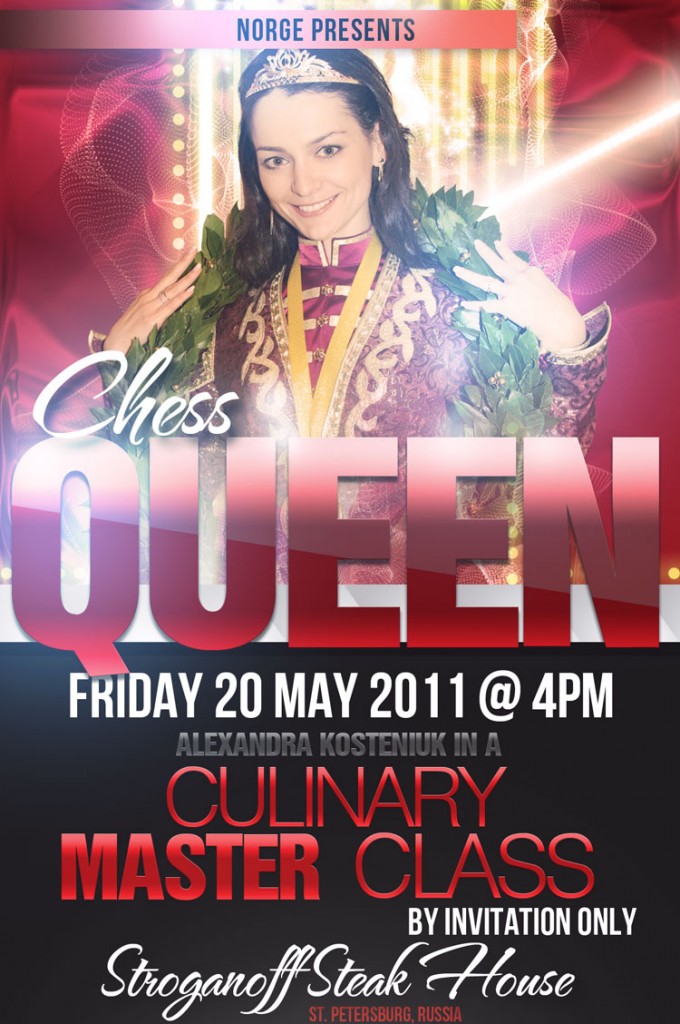
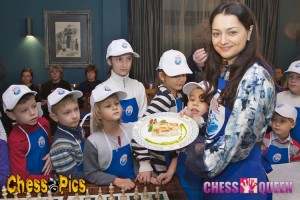















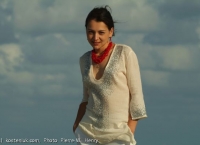





















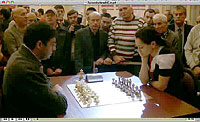
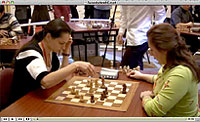
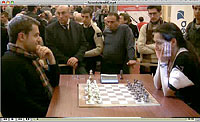

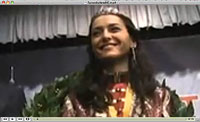
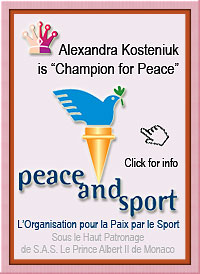
My favorite culinary masterpiece. Glenn’s Chicken and Dumplings.
1 chicken
1 stick butter
1/2 cup milk
Salt and pepper to taste
Wash and cut up chicken. Cover with water;add butter, milk, salt, and pepper. Simmer until chicken is done. Cool. Remove skin and bones.
Cut chicken into bite-sized pieces.
Dumplings
1 1/2 cups self-rising flour
1/2 cup shortening
Buttermilk
Cut shortening into flour. Add enough buttermilk to make dough. On floured board, roll dough thin. Cut into 1×2-inch strips. Heat chicken and broth until very hot. Slowly drop a few strips of dough into chicken and broth; cook as you go. Continue adding dough strips until all are added. Cook until all dough is done.